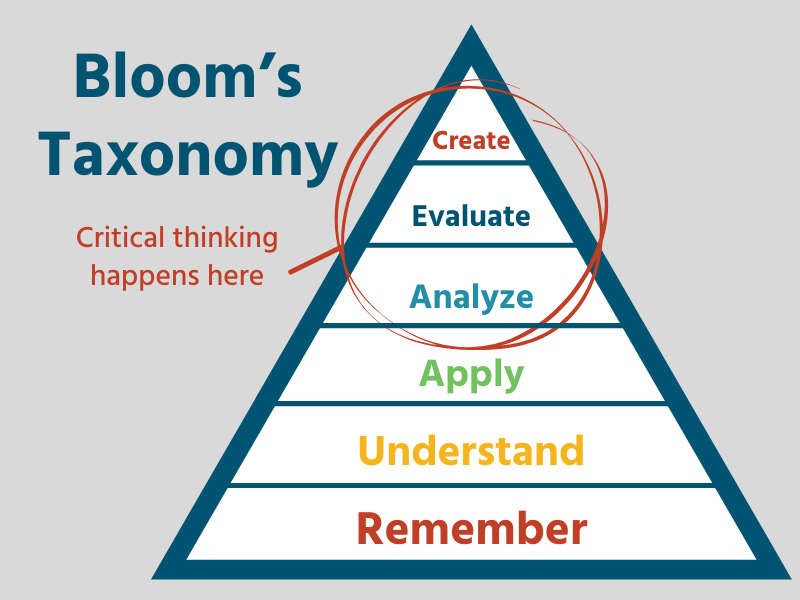
Limmer Education

by Lisa Montoya
Our articles are read by an automated voice. We offer the option to listen to our articles as soon as they are published to enhance accessibility. Issues? Please let us know using the contact form.
Do you challenge your students with critical thinking scenarios in lectures? Should you save that for the lab portion of the EMS program? Should you do both? These are questions educators have struggled with as long as there have been EMS courses.
Many of our course objectives are written and classified in Bloom Taxonomy’s lower levels of learning, such as remembering and understanding. To teach students to critically think, reaching Bloom’s levels of analyzing, evaluating, and creating[1], we can prepare them for most challenges within their EMS education and beyond.
I reach the more challenging levels in Bloom’s by creating scenarios that require knowledge from previous chapters and the current chapter. I ask them to:
Analyze by explaining the signs and symptoms.
Evaluate by assessing the signs and symptoms, vital signs, and physical findings. Hypothesize, come up with a differential diagnosis (there may be more than one).
Create a management plan for treating the patient based on the differential diagnosis.

If students work through all the information they gather, and what the patient tells them, they should be able to critically think their way through any lab scenario and clinical patient they encounter. I guide them through the learning process and let them answer the questions until they reach a point of confusion. Then, I step in to help them move to the next level of understanding. Doing this requires a facilitator—not an instructor—role.
Creating critical thinking scenarios allows the students to think through challenging topics and put the puzzle pieces together. Previously I had a student email me (my course was entirely online) that he didn’t know where to find the answers to my scenario questions; he said he couldn’t find them in the book. My response to him was, your patient doesn’t appear in one chapter; you must put all the chapters together to figure out what is wrong with your patient. To get students to think critically, they need to think outside the box.
Here is a scenario I use for the respiratory chapter:
28 y/o female found lying in bed unresponsive. Her husband tells you she had a hysterectomy last week and today, she went to the bathroom and had a sudden onset of difficulty breathing and sharp chest pain. She collapsed on the floor, and he carried her to the bed. VS: 0/0, HR 0, RR 0, skin is pale with cyanosis to her fingertips and lips, pupils are dilated and non-reactive. O2 sat will not register.
Students struggle with understanding pulmonary emboli (PE). If they understand the anatomy and physiology, they should be able to explain why it caused the patient to go into cardiac arrest. Questions I ask for this scenario:
What is your differential diagnosis?
Is she breathing adequately?
If not, what makes it inadequate?
How will you treat her?
What do you expect to hear when you assess breath sounds during ventilations?
Asking if her breathing is adequate or not may seem obvious, but I have found that they have a hard time differentiating between adequate and inadequate. If they know how to treat inadequate ventilations, they should automatically know how to treat for her apnea. This is not the first scenario they encounter in the exercise; in all the scenarios, I ask the first four questions above.
The last question usually confuses the students. It gives them a chance to explain what is truly happening with a PE and where the emboli/embolus occur. Many students think it’s in the airway passages. This gives us a chance to review the pathway of blood flow and discuss what happens when the pressure builds up in the smaller capillaries and may produce rales. The review helps them understand hydrostatic pressure and prepares them for the signs of left-sided heart failure. We also discuss that the breath sounds may be clear due to the blockage being in the circulatory system, not the airway passages. Students also answer that there won’t be any breath sounds because the patient isn’t breathing! For some of them, it’s the ah-ha moment of realizing that we create breath sounds when we ventilate, and it’s the easiest breath sound to hear (or not hear in some patients).
In some scenarios, I ask them to explain why the patient presents with an altered mental status or why their skin is cool, pale, and diaphoretic. The discussion allows them to revisit physiology and pathophysiology, which some students really struggle to comprehend.
There is so much opportunity for discussion and allowing the students to have a deeper understanding of a diagnosis if you take the time to write simple scenarios that require critical thinking. Students will thank you for the exercise, and you’ll enjoy working through it with them. It’s a win-win for both the students and the educator. Students need to feel challenged, and this is a great way to make them think.
[1] Bibi Wilayat, Muhammad Naeem Butt, and Amjad Reba. 2020. “Relating Teachers’ Questioning Techniques with Students’ Learning within the Context of Bloom’s Taxonomy.” FWU Journal of Social Sciences 14 (1): 111–19. https://search.ebscohost.com/login.aspx?direct=true&AuthType=shib&db=a9h&AN=142938613&site=ehost-live.

Limmer Education

Dan Limmer, BS, NRP

Limmer Education